Two-Dimensional (PEA)2PbBr4 Perovskites Sensors for Highly Sensitive Ethanol Vapor Detection
Abstract
:1. Introduction
2. Materials and Methods
2.1. Materials
2.2. Sensor Fabrication
2.3. Measurements
2.3.1. Current–Voltage (I–V) Curve Measurement
2.3.2. Current–Time (I–T) Curve Measurement
2.3.3. Responsivity Measurement
2.3.4. Photoluminescence (PL) Measurement
3. Results and Discussion
4. Conclusions
Author Contributions
Funding
Institutional Review Board Statement
Informed Consent Statement
Data Availability Statement
Acknowledgments
Conflicts of Interest
References
- Das, S.; Pal, S.; Mitra, M. Significance of Exhaled Breath Test in Clinical Diagnosis: A Special Focus on The Detection of Diabetes Mellitus. J. Med. Biol. Eng. 2016, 36, 605–624. [Google Scholar] [CrossRef] [PubMed] [Green Version]
- Jalal, A.H.; Alam, F.; Roychoudhury, S.; Umasankar, Y.; Pala, N.; Bhansali, S. Prospects and Challenges of Volatile Organic Compound Sensors in Human Healthcare. ACS Sens. 2018, 3, 1246–1263. [Google Scholar] [CrossRef] [PubMed]
- Tien, C.H.; Chen, L.C.; Lee, K.L. Ultra-thin and high transparent Cu2ZnSnSe4/NiOx Double-Layered Inorganic Hole-Transporting Layer for Inverted Structure CH3NH3PbI3 Perovskite Solar Cells. J. Alloys Compd. 2021, 873, 159804. [Google Scholar] [CrossRef]
- Yoon, E.; Jang, K.Y.; Park, J.; Lee, T.W. Understanding the Synergistic Effect of Device Architecture Design Toward Efficient Perovskite Light-Emitting Diodes Using Interfacial Layer Engineering. Adv. Mater. Interfaces 2021, 8, 2001712. [Google Scholar] [CrossRef]
- Pintor Monroy, M.I.; Goldberg, I.; Elkhouly, K.; Georgitzikis, E.; Clinckemalie, L.; Croes, G.; Annavarapu, N.; Qiu, W.; Debroye, E.; Kuang, Y.; et al. All-Evaporated, All-Inorganic CsPbI3 Perovskite-Based Devices for Broad-Band Photodetector and Solar Cell Applications. ACS Appl. Electron. Mater. 2021, 3, 3023–3033. [Google Scholar] [CrossRef]
- Harwell, J.R.; Whitworth, G.L.; Turnbull, G.A.; Samuel, I.D.W. Green Perovskite Distributed Feedback Lasers. Sci. Rep. 2017, 7, 11727. [Google Scholar] [CrossRef] [Green Version]
- Kim, G.H.; Kim, D.S. Development of Perovskite Solar Cells With >25% Conversion Efficiency. Joule 2021, 5, 1033–1035. [Google Scholar] [CrossRef]
- National Renewable Energy Laboratory. Best Research-Cell Efficiencies. Available online: https://www.nrel.gov/pv/assets/pdfs/best-research-cell-efficiencies-rev220630.pdf (accessed on 30 June 2022).
- Du, P.; Gao, L.; Tang, J. Focus on Performance of Perovskite Light-Emitting Diodes. Front. Optoelectron. 2020, 13, 235–245. [Google Scholar] [CrossRef]
- Gebremichael, B.; Alemu, G.; Mola, G.T. Conductivity of CH3NH3PbI3 Thin Film Perovskite Stored in Ambient Atmosphere. Physical B 2017, 514, 85–88. [Google Scholar] [CrossRef]
- Zhu, Z.; Sun, Q.; Zhang, Z.; Dai, J.; Xing, G.; Li, S.; Huang, X.; Huang, W. Metal Halide Perovskites: Stability and Sensing-Ability. J. Mater. Chem. C 2018, 6, 10121–10137. [Google Scholar] [CrossRef]
- Haque, M.A.; Syed, A.; Akhtar, F.H.; Shevate, R.; Singh, S.; Peinemann, K.V.; Baran, D.; Wu, T. Giant Humidity Effect on Hybrid Halide Perovskite Microstripes: Reversibility and Sensing Mechanism. ACS Appl. Mater. Interfaces 2019, 11, 29821–29829. [Google Scholar] [CrossRef] [PubMed]
- Stoeckel, M.A.; Gobbi, M.; Bonacchi, S.; Liscio, F.; Ferlauto, L.; Orgiu, E.; Samori, P. Reversible, Fast, and Wide-Range Oxygen Sensor Based on Nanostructured Organometal Halide Perovskite. Adv. Mater. 2017, 29, 1702469. [Google Scholar] [CrossRef] [PubMed] [Green Version]
- Hien, V.X.; Hoat, P.D.; Hung, P.T.; Lee, S.; Lee, J.H.; Heo, Y.W. Room-Temperature NO2 Sensor Based on a Hybrid Nanomaterial of Methylammonium Tin Iodide Submicron Spheres and Tin Dioxide Nanowires. Scr. Mater. 2020, 188, 107–111. [Google Scholar] [CrossRef]
- Reddy, B.K.S.; Borse, P.H. Review-Recent Material Advances and Their Mechanistic Approaches for Room Temperature Chemiresistive Gas Sensors. J. Electrochem. Soc. 2021, 168, 057521. [Google Scholar] [CrossRef]
- Jiao, W.; He, J.; Zhang, L. Synthesis and High Ammonia Vapor Sensitivity of (CH3NH3)PbBr3-xIx Perovskite Thin Film at Room Temperature. Sens. Actuators B 2020, 309, 127786. [Google Scholar] [CrossRef]
- Parfenov, A.A.; Yamilova, O.R.; Gutsev, L.G.; Sagdullina, D.K.; Novikov, A.V.; Ramachandran, B.R.; Stevenson, K.J.; Aldoshin, S.M.; Troshin, P.A. Highly Sensitive and Selective Ammonia Vapor Sensor Based on FAPbCl3 Lead Halide Perovskites. J. Mater. Chem. C 2021, 9, 2561–2568. [Google Scholar] [CrossRef]
- Maity, A.; Mitra, S.; Das, C.; Siraj, S.; Raychaudhuri, A.K.; Ghosh, B. Universal Sensing of Ammonia Gas by Family of Lead Halide Perovskites Based on Paper Sensors: Experiment and Molecular Dynamics. Mater. Res. Bull. 2021, 136, 111142. [Google Scholar] [CrossRef]
- Bao, C.X.; Yang, J.; Zhu, W.D.; Zhou, X.X.; Gao, H.; Li, F.M.; Fu, G.; Yu, T.; Zou, Z.G. A Resistance Change Effect in Perovskite CH3NH3PbI3 Films Induced by Ammonia. Chem. Commun. 2015, 51, 15426–15429. [Google Scholar] [CrossRef]
- Senocrate, A.; Kim, G.Y.; Grätzel, M.; Maier, J. Thermochemical Stability of Hybrid Halide Perovskites. ACS Energy Lett. 2019, 4, 2859–2870. [Google Scholar] [CrossRef] [Green Version]
- Lang, F.; Shargaieva, O.; Brus, V.V.; Neitzert, H.C.; Rappich, J.; Nickel, N.H. Influence of Radiation on The Properties and The Stability of Hybrid Perovskites. Adv. Mater. 2018, 30, 1702905. [Google Scholar] [CrossRef]
- Majeed, S.M.; Ahmed, D.S.; Mohammed, M.K.A. Anti-Solvent Engineering Via Potassium Bromide Additive for Highly Efficient and Stable Perovskite solar cells. Organ. Electron. 2021, 99, 106310. [Google Scholar] [CrossRef]
- Ponchai, J.; Srathongsian, L.; Amratisha, K.; Boonthum, C.; Sahasithiwat, S.; Ruankham, P.; Kanjanaboos, P. Modified Colored Semi-transparent Perovskite Solar Cells with Enhanced Stability. J. Alloys Compd. 2021, 875, 159781. [Google Scholar] [CrossRef]
- Frolova, L.A.; Gutsev, L.G.; Ramachandran, B.R.; Dremova, N.N.; Aldoshin, S.M.; Troshin, P.A. Exploring CsPbI3–FAI Alloys: Introducing Low-Dimensional Cs2FAPb2I7 Absorber for Efficient and Stable Perovskite Solar Cells. Chem. Eng. J. 2021, 426, 131754. [Google Scholar] [CrossRef]
- Parikh, N.; Tavakoli, M.M.; Pandey, M.; Kumar, M.; Prochowicz, D.; Chavan, R.D.; Yadav, P. Two-Dimensional Halide Perovskite Single Crystals: Principles and Promises. Emergent Mater. 2021, 4, 865–880. [Google Scholar] [CrossRef]
- Singh, R.; Singh, P.; Balasubramanian, G. Effect of Heterostructure Engineering on Electronic Structure and Transport Properties of Two-Dimensional Halide Perovskites. Comput. Mater. Sci. 2021, 200, 110823. [Google Scholar] [CrossRef]
- Kim, E.B.; Akhtar, M.S.; Ameen, S.; Nazeeruddin, M.K. A Review on Two-Dimensional (2D) and 2D-3D Multidimensional Perovskite Solar Cells: Perovskites Structures, Stability, And Photovoltaic Performances. J. Photochem. Photobiol. C 2021, 48, 100405. [Google Scholar] [CrossRef]
- Ghasemi, M.; Lyu, M.; Roknuzzaman, M.; Yun, J.H.; Hao, M.; He, D.; Bai, Y.; Chen, P.; Bernhardt, P.V.; Ostrikov, K.; et al. Phenethylammonium Bismuth Halides: From Single Crystals to Bulky-Organic Cation Promoted Thin-Film Deposition for Potential Optoelectronic Applications. J. Mater. Chem. A 2019, 7, 20733–20741. [Google Scholar] [CrossRef]
- Cheng, B.; Li, T.Y.; Wei, P.C.; Yin, J.; Ho, K.T.; Retamal, J.R.D.; Mohammed, O.F.; He, J.H. Layer-Edge Device of Two-Dimensional Hybrid Perovskites. Nat. Commun. 2018, 9, 5196. [Google Scholar] [CrossRef] [Green Version]
- Duong, T.; John, A.T.; Chen, H.; Pham, H.; Murugappan, K.; Tran-Phu, T.; Tricoli, A.; Catchpole, K. Mixed-Dimensional Organic–Inorganic Metal Halide Perovskite (OIMHP) Based Gas Sensors with Superior Stability for NO2 Detection. Mater. Adv. 2022, 3, 1263–1271. [Google Scholar] [CrossRef]
- Mat Yunin, M.Y.A.; Mohd Adenam, N.; Khairul, W.M.; Yusoff, A.H.; Adli, H.K. Effect of Stability of Two-Dimensional (2D) Aminoethyl Methacrylate Perovskite Using Lead-Based Materials for Ammonia Gas Sensor Application. Polymers 2022, 14, 1853. [Google Scholar] [CrossRef]
- Li, Z.; Yi, J. Enhanced Ethanol Sensing of Ni-Doped SnO2 Hollow Spheres Synthesized by a One-Pot Hydrothermal Method. Sens. Actuators B 2017, 243, 96–103. [Google Scholar] [CrossRef]
- Tong, W.; Wang, Y.; Bian, Y.; Wang, A.; Han, N.; Chen, Y. Sensitive Cross-Linked SnO2:NiO Networks for MEMS Compatible Ethanol Gas Sensors. Nanoscale Res. Lett. 2020, 15, 35. [Google Scholar] [CrossRef] [PubMed]
- Yu, J.; Wang, C.; Yuan, Q.; Yu, X.; Wang, D.; Chen, Y. Ag-Modified Porous Perovskite-Type LaFeO3 for Efficient Ethanol Detection. Nanomaterials 2022, 12, 1768. [Google Scholar] [CrossRef] [PubMed]
- Ochoa-Muñoz, Y.H.; Mejía de Gutiérrez, R.; Rodríguez-Páez, J.E.; Gràcia, I.; Vallejos, S. Gas Sensors Based on Porous Ceramic Bodies of MSnO3 Perovskites (M = Ba, Ca, Zn): Formation and Sensing Properties towards Ethanol, Acetone, and Toluene Vapours. Molecules 2022, 27, 2889. [Google Scholar] [CrossRef] [PubMed]
- Suematsu, K.; Hiroyama, Y.; Watanabe, K.; Shimanoe, K. Amplifying the Receptor Function on Ba0.9La0.1FeO3-SnO2 Composite Particle Surface for High Sensitivity Toward Ethanol Gas Sensing. Sens. Actuators B 2022, 354, 131256. [Google Scholar] [CrossRef]
- Nga Phan, T.T.; My Dinh, T.T.; Duc Nguyen, M.; Dan, L.; Nhan Phan, C.; Kien Pham, T.; Tu Nguyen, C.; Huyen Pham, T. Hierarchically Structured LaFeO3 with Hollow Core and Porous Shell as Efficient Sensing Material for Ethanol Detection. Sens. Actuators B 2022, 354, 131195. [Google Scholar] [CrossRef]
- Yin, Y.; Shen, Y.; Zhao, S.; Bai, J.; Qi, Y.; Han, C.; Wei, D. Effect of Noble Metal Elements on Ethanol Sensing Properties of ZnSnO3 Nanocubes. J. Alloys Compd. 2021, 887, 161409. [Google Scholar] [CrossRef]
- Li, F.; Lv, Q.; Gao, L.; Zhong, X.; Zhou, J.; Gao, X. Ultra-Sensitive Ag-LaFeO3 for Selective Detection of Ethanol. J. Mater. Sci. 2021, 56, 15061–15068. [Google Scholar] [CrossRef]
- Jiao, W.; He, J.; Zhang, L. Fabrication and Investigation of a New All-Inorganic Lead Free Perovskite Cs3Bi2I6Br3 for Ammonia Detection At Room Temperature. J. Alloys Compd. 2022, 895, 162561. [Google Scholar] [CrossRef]

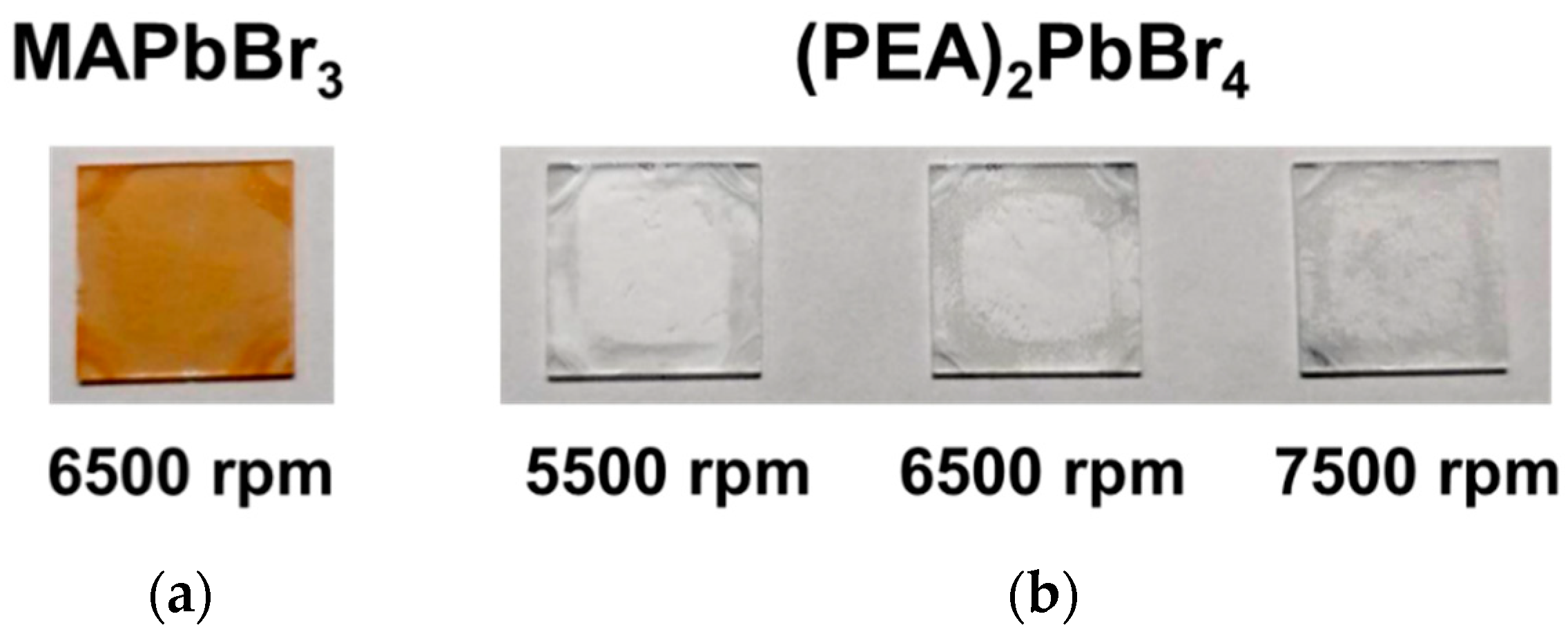

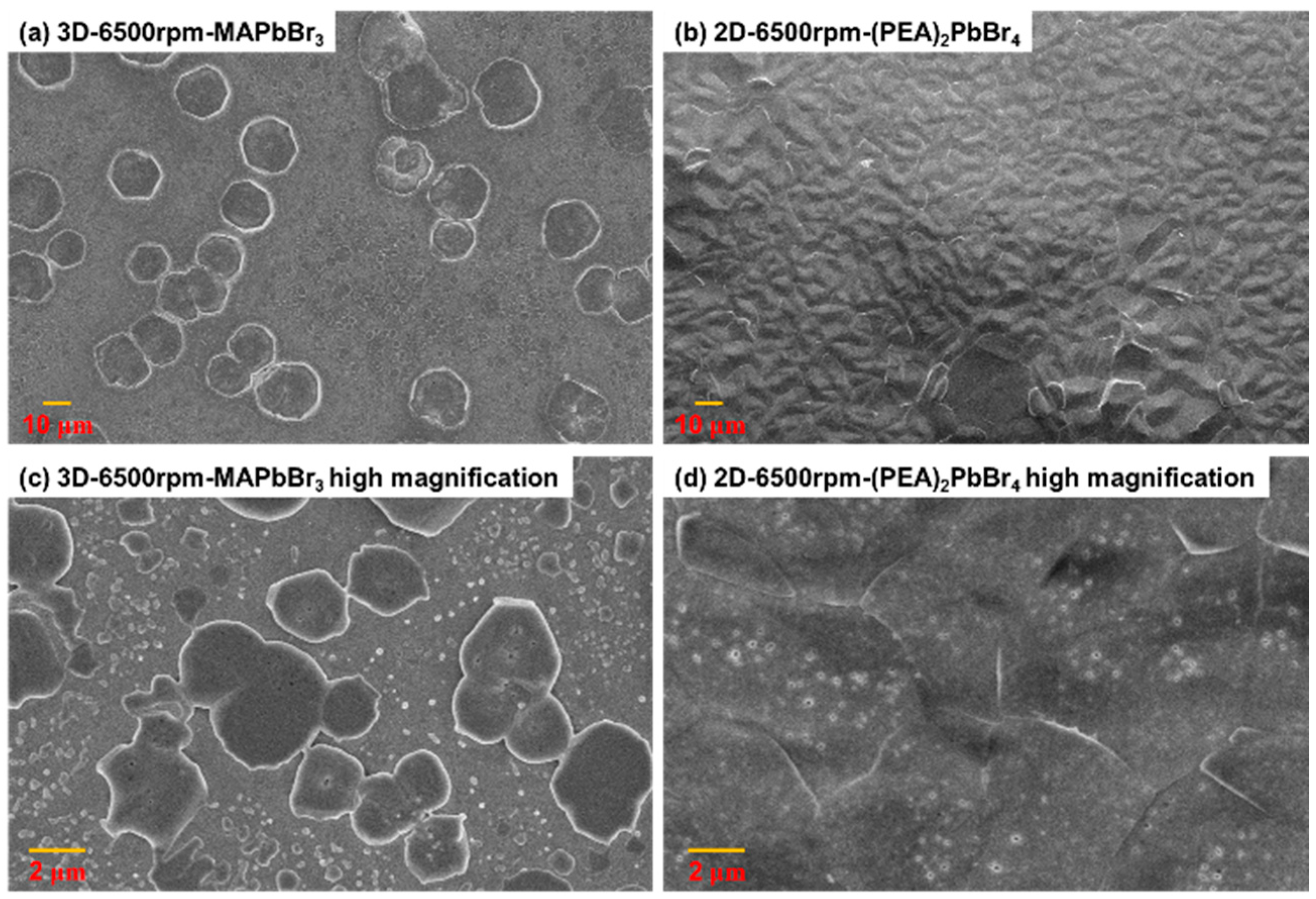

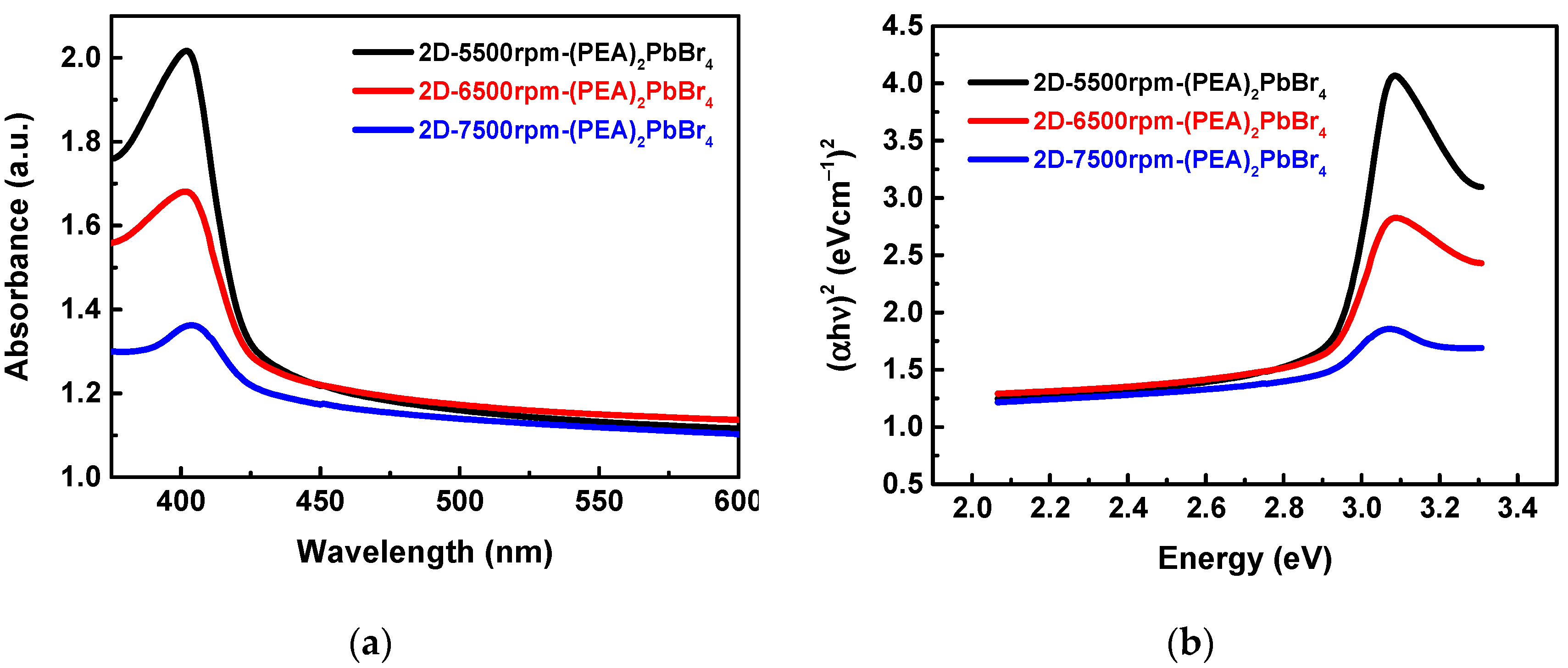
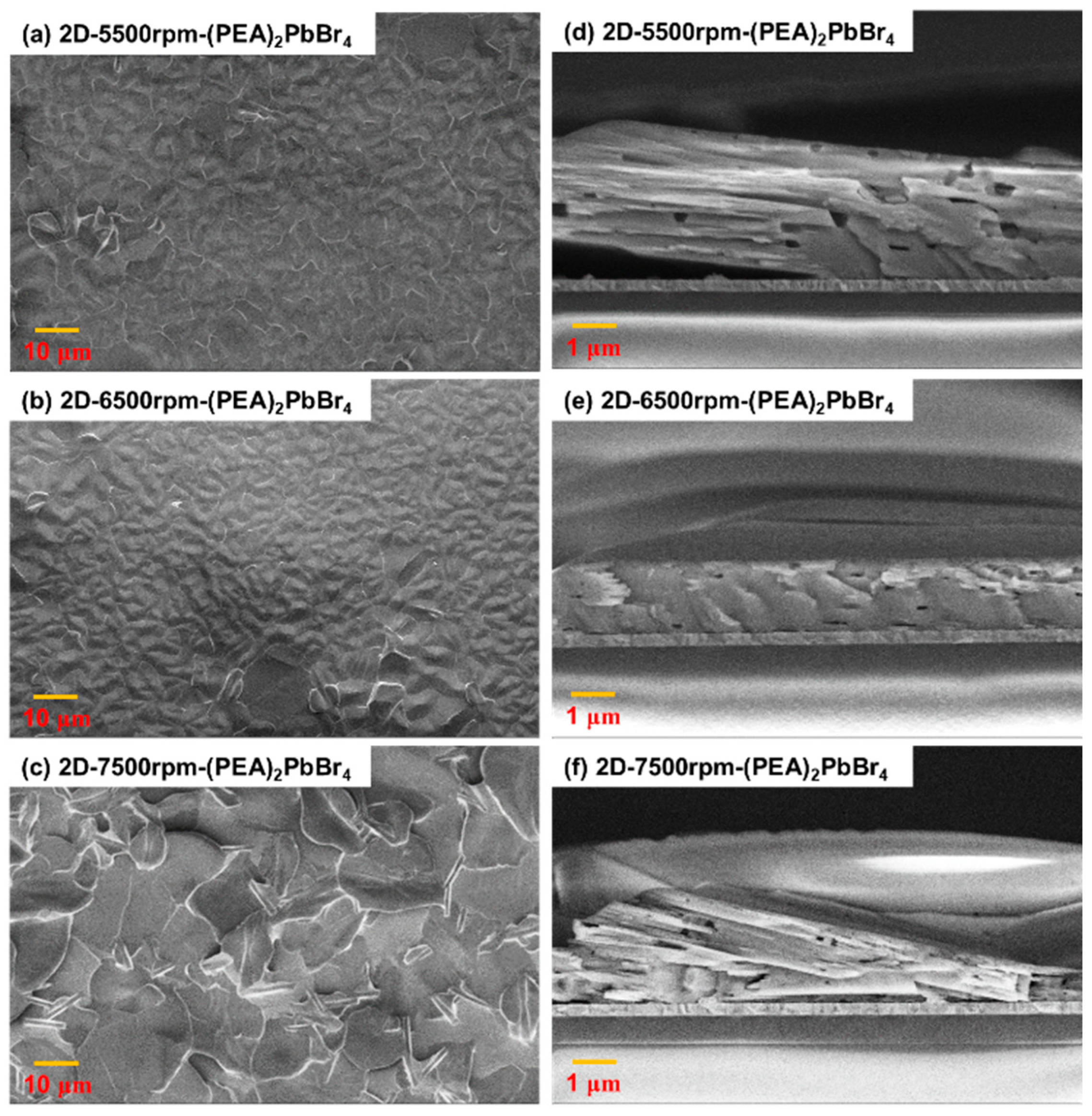
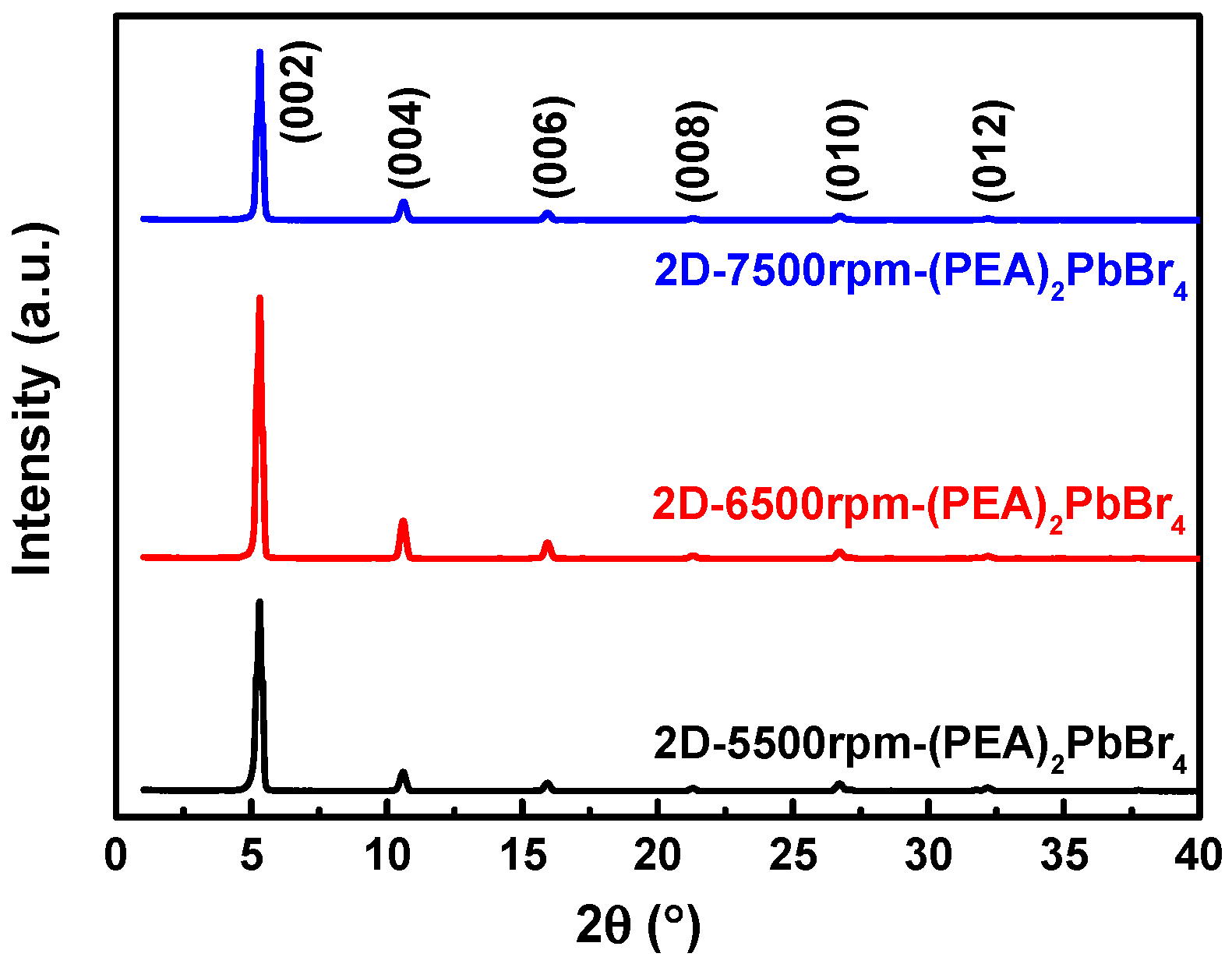


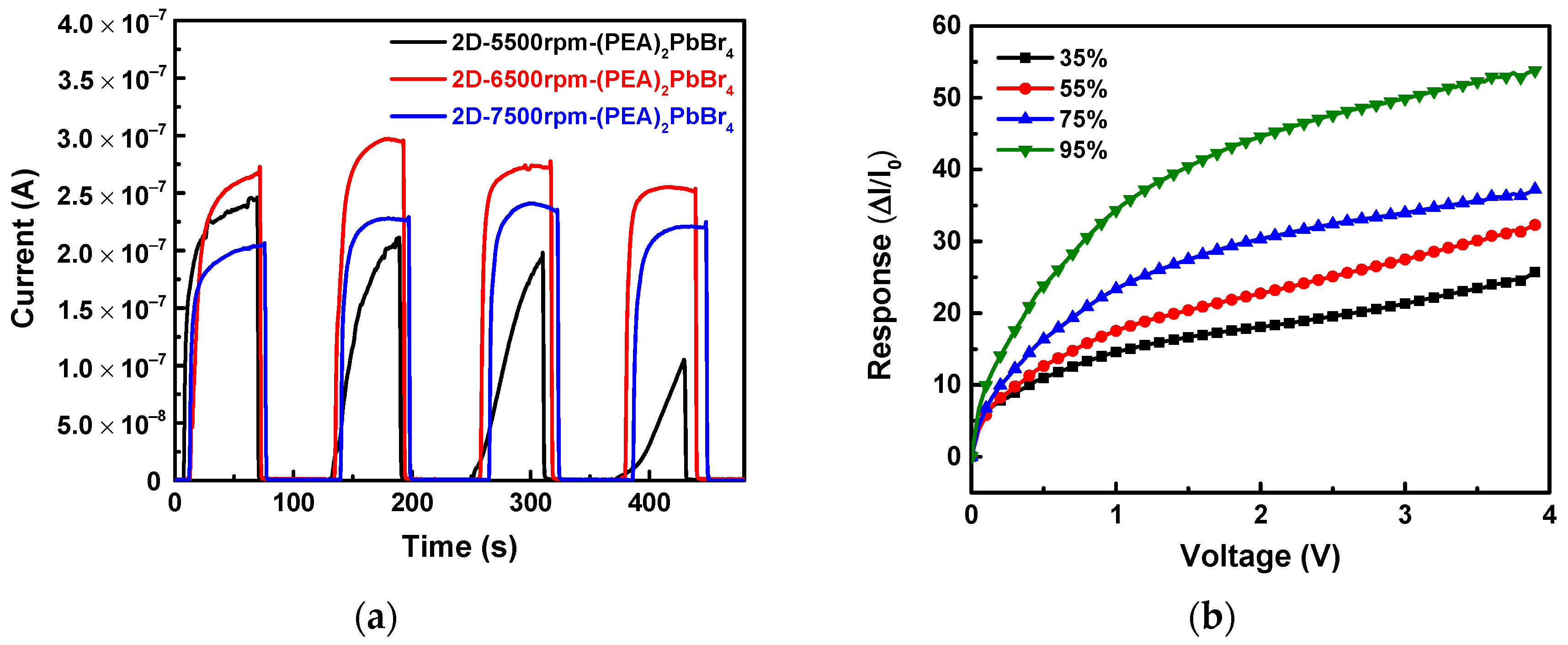
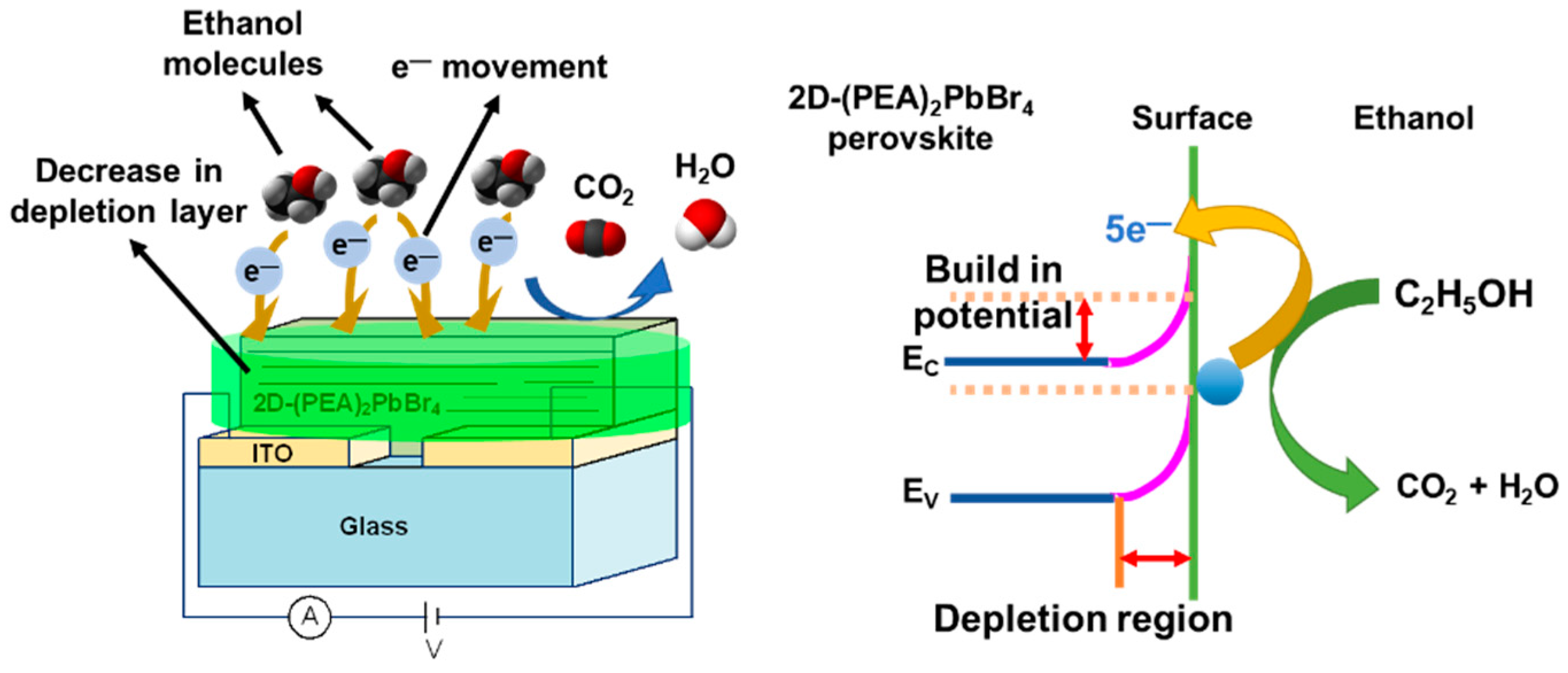
| Material | Operating Temperature (°C) | Concentration (ppm) | Response | Response/Recovery Time (s) | Year/Ref. |
|---|---|---|---|---|---|
| Ag/LaFeO3 | 180 | 20 | 21 | 26/27 | 2022/[34] |
| ZnSnO3 porous bodies | 270 | 80 | 37 | 4/581 | 2022/[35] |
| BaSnO3 porous bodies | 270 | 80 | 14.3 | 72/596 | 2022/[35] |
| Ba0.9La0.1FeO3 | 250 | 1 | 143 | -- | 2022/[36] |
| Hollow LaFeO3 | 300 | 143 | 14.5 | 23/39 | 2022/[37] |
| Ag–ZnSnO3 | 200 | 100 | 83.9 | 1/50 | 2021/[38] |
| Ag-LaFeO3 | 190 | 100 | 155 | 30/5 | 2021/[39] |
| Cs3Bi2I6Br3 | RT | 500 | 3.7 | -- | 2022/[40] |
| (PEA)2PbBr4 | RT | 10000 | 107.32 | 8.83/0.43 | This work |
Publisher’s Note: MDPI stays neutral with regard to jurisdictional claims in published maps and institutional affiliations. |
© 2022 by the authors. Licensee MDPI, Basel, Switzerland. This article is an open access article distributed under the terms and conditions of the Creative Commons Attribution (CC BY) license (https://creativecommons.org/licenses/by/4.0/).
Share and Cite
Tien, C.-H.; Lee, K.-L.; Tao, C.-C.; Lin, Z.-Q.; Lin, Z.-H.; Chen, L.-C. Two-Dimensional (PEA)2PbBr4 Perovskites Sensors for Highly Sensitive Ethanol Vapor Detection. Sensors 2022, 22, 8155. https://doi.org/10.3390/s22218155
Tien C-H, Lee K-L, Tao C-C, Lin Z-Q, Lin Z-H, Chen L-C. Two-Dimensional (PEA)2PbBr4 Perovskites Sensors for Highly Sensitive Ethanol Vapor Detection. Sensors. 2022; 22(21):8155. https://doi.org/10.3390/s22218155
Chicago/Turabian StyleTien, Ching-Ho, Kuan-Lin Lee, Chun-Cheng Tao, Zhan-Qi Lin, Zi-Hao Lin, and Lung-Chien Chen. 2022. "Two-Dimensional (PEA)2PbBr4 Perovskites Sensors for Highly Sensitive Ethanol Vapor Detection" Sensors 22, no. 21: 8155. https://doi.org/10.3390/s22218155





